
BSc (Guelph), MSc (McGill), PhD (Dalhousie)
Reader
- Email Address
- c.t.marshall@abdn.ac.uk
- Telephone Number
- +44 (0)1224 272278
- Office Address
School of Biological Sciences Zoology Bldg., Z413 Tillydrone Ave. Aberdeen AB24 2TZ Scotland
- School/Department
- School of Biological Sciences
External Memberships
- Associate Editor for the Canadian Journal of Fisheries and Aquatic Sciences (see http://pubs.nrc-cnrc.gc.ca/eng/home.html)
- UK delegate and co-chair of working group 3 of the EU Cost Action FRESH (see http://www.fresh-cost.org/)
- member of the North Atlantic Fisheries Organization (NAFO) Working Group on Reproductive Potential (see http://www.iim.csic.es/pesquerias/NAFOWGRP/intro.htm)
- member of the International Council for the Exploration of the Sea (ICES) Arctic Fisheries Working Group (see http://www.ices.dk/indexfla.asp)
- member of consultative group of Scottish Industry/Science Partnership
Research Overview
The overall aims of my research are to determine causes and consequences of variation in the life history of fish and to develop practical tools for implementing this knowledge into fisheries management.
The ocean is our research laboratory. We undertake collaborative research projects in a range of different ecosystems including:
- sarcto-boreal ecosystems off the coast of Newfoundland and in the Barents Sea
- shelf sea in the Southern Ocean surrounding South Georgia Island
- coastal seas such as the North Sea and Norwegian Sea
- estuarine conditions in the Northern Gulf of St Lawrence and the Baltic Sea.
We sample these ecosystems by participating in research vessel surveys and by accessing long-term databases generated from these surveys or from sampling of the commercial catch.
Much of our research focuses on two commercial species: cod and herring. Both have undergone well-documented collapses. Herring stocks in the North Sea and Norwegian Sea were overfished in the 1970s but were successfully rebuilt in the 1990s. Cod stocks in the Northwest Atlantic, North Sea and Baltic Sea are depleted or collapsed whereas the Barents Sea cod stock is currently above safe biological limits.



Current Research
Fish as key bioeconomic resources
Commercial fisheries are important socio-economic resources. Because large-scale fisheries are often prosecuted by a number of different groups, management must operate by consensus if biological, economic and social sustainability is to be achieved. This requires effective means for attaining sustainable harvesting practices. Increasingly, my research is branching out into aspects of the bioeconomic performance of commercial fisheries. This includes investigating how short-term variability in fishers’ landings is generated because these fluctuations can influence economic returns from a fishery. Explaining short-term variability in landings could help to stabilise fisheries management and long-term landings. Another research theme has been examined is the impact of harvesting (or discarding) immature fish before they have spawned on sustainability. Future research will determine whether it is more economically and biologically sensible to allow fish to grow and reproduce in the future rather than harvest them now.

The ecological resiliency of populations to harvesting
The intrinsic rate of population growth (r) expresses the exponential rate of increase when abundance is low. Species having high r are regarded as inherently more resilient to harvesting compared to species having low r. Applying the same reasoning to a single harvested species, we would predict that r for stable or increasing populations should be sufficiently high to compensate for losses imposed by fishing whereas r for collapsed populations would be too low. To test this prediction we estimated cohort-specific r for two cod stocks, one currently within safe biological limits (Barents Sea cod) and the other collapsed since 1993 (Northern Gulf of St. Lawrence cod). Population increase in the healthy cod stock occurred when r was positive even after accounting for fishing. In the collapsed stock r was negative for several consecutive cohorts, effectively eliminating the stocks resiliency to fishing. Failure to recognize the magnitude of cohort-specific variation in r has led to misperceptions about the ability of depleted or collapsed populations to rebuild within desired time scales. We are now applying this analytical approach to model the collapse and recovery of Norwegian spring-spawning herring.



Climate-mediated changes in condition
Both reproduction and survival are affected by the "health" or condition of its individuals. Condition indices (CI) are used to represent the magnitude of stored energy reserves. Morphometric CI, analogous to Body Mass Index used for humans, are frequently used in roundfish species. We recently collaborated on research which suggests that a long-term trend towards decreased CI of salmon in two Scottish rivers is the result of increasing temperatures in the North Atlantic. Cod store lipids in their liver, consequently, the ratio of liver weight to body weight is a sensitive CI. Using a unique Russian database on liver weight of Barents Sea cod we have shown that temporal variability in the magnitude of stored energy is driven by fluctuations in both food and temperature. Herring are an oily fish storing a high proportion of lipids in their muscle tissue. Spatial variability in the fat content of North Sea herring has been investigated using a hand-held fat meter. Immature herring exhibit a south to north gradient in their fat content which could reflect a spatial gradient in availability of calanoid copepods. This research theme suggests that climate-mediated changes in availability of prey or temperature will have profound consequences for CI and therefore the population dynamics of many marine fish resources.




The ecophysiology of maturation
The rate at which individuals become sexually mature is a key determinant of the population growth rate, r. Many exploited fish stocks are maturing earlier. This could be a rapid evolutionary response to high selection pressure. Alternatively, changes in ecosystem functioning may also have contributed to energetic status of individuals so as to favour earlier maturation. Disentangling the genetic and environmental drivers that contribute to interannual variability in maturation rates is currently an active area of research. Herring are particularly plastic with respect to maturation rates which adds considerable uncertainty to management advice. The aim of our research is to describe the morphological, hormonal and gonadal changes which occur well in advance of maturation. Field sampling includes the measurement of fat content in muscles, steroid hormones in blood plasma, and structural changes in gonad tissue.



Tools for fisheries management
To achieve our aim of developing practical tools for implementing ecological knowledge into fisheries management we participate in a diverse range of collaborative projects:
- model variation in growth rates of individuals so as to improve short-term forecasts (with FRS Marine Lab)
- develop policy advice for rebuilding European fish stocks (with 17 partners)
- evaluate the performance of alternative indices of stock reproductive potential in management strategy evaluations (with 12 member countries)
- determine the likelihood of meeting international commitments to rebuilding stocks by 2015 (in collaboration with Cefas)
Several honours projects have been undertaken which use ICES databases to evaluate the long-term consequences of harvesting immature individuals.



Funding and Grants
June 2007: European Commission Cost Action FA0601awarded to consortium of 12 European countries for 4 years Fish Reproduction and Fisheries (ca €85,000 pa awarded to consortium to support training schools, workshops and symposia)
May 2007: BBSRC Quota PhD studentship Identifying hormonal and morphological markers associated with maturation in North Sea herring
Mar 2007: FRS Marine Laboratory ROAME Fisheries-induced evolution (£109,810)
Jan 2007: FRS Marine Laboratory ROAME An investigation into the visual assessment of maturity status in North Sea herring (£5,740)
Sep 2006: FRS Marine Laboratory Research Studentship Incorporating fish growth models in medium-term stock projections (£50,035)
Mar 2006: Royal Society Research Grants scheme Testing for developmental thresholds for maturation in North Sea herring (£10,910)
Feb 2006: The Nuffield Foundation Undergraduate research bursary Are visual assessments of maturity status for North Sea herring accurate? (£1,420)
Jan 2006: Royal Society of Edinburgh International Exchange Programme Visit of Dr. N.A. Yaragina (Polar Research Institute of Marine Fisheries and Oceanography, Murmansk) to University of Aberdeen (£1,810)
Jan 2006: FP6 European Commission UNCOVER – UNderstanding the mechanisms of stock reCOVERy (ca. £130,158)
May 2005: CASE partner Distell.com Do lipids impose a developmental threshold on the maturation of North Sea herring? (£4,500)
May 2005: BBSRC Quota CASE PhD studentship Do lipids impose a developmental threshold on the maturation of North Sea herring? (ca. £42,000)
Mar 2005: Royal Society of Edinburgh International Exchange Programme Trip to Polar Research Institute of Marine Fisheries and Oceanography, Murmansk (£1,464)
May 2004: BBSRC PhD studentship Time series analysis of cod bioenergetics with application to fish stock management (ca. £42,000)
Teaching Responsibilities
- Degree Programme Co-ordinator: Marine Biology degree
- Course co-ordinator: ZO4538 Marine and Fisheries Biology, ZO5007 Fish Biology module in MSc programme
- Course contributor: BI25Z2 Ocean Biology, BI29Z1 Fish and Shellfish Biology Field Course, ZO3508 Marine Ecology and Ecosystems, ZO3303 Animal Population Ecology
Page 3 of 6 Results 21 to 30 of 55
Interannual variability in reproductive traits of the Patagonian toothfish Dissostichus eleginoides around the sub-Antarctic island of South Georgia
Brigden, K. E., Marshall, C. T., Scott, B. E., Young, E. F., Brickle, P.Journal of Fish Biology, vol. 91, no. 1, pp. 278-301Contributions to Journals: Articles- [ONLINE] DOI: https://doi.org/10.1111/jfb.13344
Shifts in spawning phenology of cod linked to rising sea temperatures
McQueen, K., Marshall, C. T.ICES Journal of Marine Science, vol. 74, no. 6, pp. 1561-1573Contributions to Journals: ArticlesSMARTFISH: Selective management and retention of target fish FIS011B: FIS011 Developing and facilitating a range of possible future FIS projects in innovation in selectivity through on-net or alternative technologies
Marshall, C., Wiff Onetto, R., Rosen, S., Neilson, R., Campos, R., Hwang, J., Fernandes, P.Fisheries Innovation Scotland (FIS). 67 pagesBooks and Reports: Commissioned ReportsUsing commercial and survey data to infer real-time fish distribution in the North Sea at high resolution: Fishing Industry Science Alliance (FISA Project 01/15)
Marshall, C., Wiff, R., Cornulier, T.Marine Scotland Science. 74 pagesBooks and Reports: Commissioned Reports- [ONLINE] DOI: https://doi.org/10.7489/1973-1
The unfulfilled potential of fisheries selectivity to promote sustainability
Vasilakopoulos, P., O'Neill, F. G., Marshall, C. T.Fish and Fisheries, vol. 17, no. 2, pp. 399-416Contributions to Journals: Articles- [ONLINE] DOI: https://doi.org/10.1111/faf.12117
- [ONLINE] View publication in Scopus
Assessing consistency of fish survey data: uncertainties in the estimation of mackerel icefish (Champsocephalus gunnari) abundance at South Georgia
Fallon, N. G., Collins, M. A., Marshall, C. T., Fernandes, P. G.Polar Biology, vol. 39, no. 4, pp. 593-603Contributions to Journals: ArticlesJohan Hjort Symposium on Recruitment Dynamics and Stock Variability
Kjesbu, O. S., Marshall, C. T., Nash, R. D. M., Sundby, S., Rothschild, B. J., Sinclair, M.Canadian Journal of Fisheries and Aquatic Sciences, vol. 73, no. 2, pp. VII-XIContributions to Journals: Editorials- [ONLINE] DOI: https://doi.org/10.1139/cjfas-2015-0491
Real-time spatial management approaches to reduce bycatch and discards: Experiences from Europe and the United States
Little, A. S., Needle, C. L., Hilborn, R., Holland, D. S., Marshall, C. T.Fish and Fisheries, vol. 16, no. 4, pp. 576-602Contributions to Journals: Articles- [ONLINE] DOI: https://doi.org/10.1111/faf.12080
- [ONLINE] View publication in Scopus
Resilience and tipping points of an exploited fish population over six decades
Vasilakopoulos, P., Marshall, C. T.Global Change Biology, vol. 21, no. 5, pp. 1834-1847Contributions to Journals: Articles- [ONLINE] DOI: https://doi.org/10.1111/gcb.12845
Maturation shifts in a temperate marine fish population cannot be explained by simulated changes in temperature-dependent growth and maturity
Wright, P. J., Palmer, S. C. F., Marshall, C. T.Marine Biology, vol. 161, no. 12, pp. 2781-2790Contributions to Journals: Articles- [ONLINE] DOI: https://doi.org/10.1007/s00227-014-2543-2





